Expenditures of the Aged Chartbook
About This Chartbook
Source of the Data
Expenditures of the Aged Chartbook is based on data from the 2002 Consumer Expenditure Survey Public-Use File. The survey provides continuous comprehensive data on the buying habits of U.S. consumers. The survey is representative of the total civilian noninstitutionalized population of the United States, as well as that portion of the institutionalized population living in some group quarters (excluding military personnel living on military bases and residents of nursing homes).
The Consumer Expenditure Survey program consists of two separate components, each with its own questionnaire and independent sample:
- An interview survey that collects data on monthly expenditures such as housing
- A diary survey that collects weekly expenditures of frequently purchased items such as food and beverages.
The Census Bureau collects the data under contract with the Bureau of Labor Statistics. Further details on the Consumer Expenditure Survey program can be obtained from the survey's home page. Documentation on the two survey components and their integration as well as limitations of the data are found on the Frequently Asked Questions page. In this chartbook, medians and distributions are calculated using only the interview survey. Means are calculated using data from both the interview and diary surveys.
Surveys are subject to sampling error because observations are not taken for the entire population. Standard errors have been calculated for all means presented in this chartbook, and differences in means noted in the text are significant at the 95 percent confidence level.
Definition and Explanation of Key Terms
The definitions of key terms are abbreviated versions of those used by the Bureau of Labor Statistics. More detailed definitions can be found in the Glossary.
Unit of analysis
- Consumer unit
- Expenditures in the Consumer Expenditure Survey are measured for the consumer unit (CU), defined as members of a household related by blood, marriage, adoption, or some other legal arrangement; a single person living alone or sharing a household with others but who is financially independent; or two or more persons living together who share responsibility for at least two out of three major types of expenses—food, housing, and other expenses. Students living in university-sponsored housing also are included in the sample as separate consumer units. The Consumer Expenditure Survey is a survey of the noninstitutionalized population and therefore does not include nursing home residents and their expenditures.
- Reference person
- The first consumer unit member mentioned by the respondent when asked to "Start with the name of the person or one of the persons who owns or rents the home." The relationship of the other consumer members of the unit is determined with respect to this person.
- Age of the consumer unit
- The age of the reference person.
- Size of the consumer unit
-
The number of persons whose usual place of residence at the time of the interview is in the sample unit. In the interview portion of the 2002 Consumer Expenditure Survey, the size of the consumer unit decreased as the age of the CU increased, as shown in the chart below.
The average number of persons in a consumer unit, by age of the unit, was 2.2 for CUs aged 55–64, 1.9 for those aged 65–74, and 1.5 for those 75 or older.
Percentage of CUs, by size and age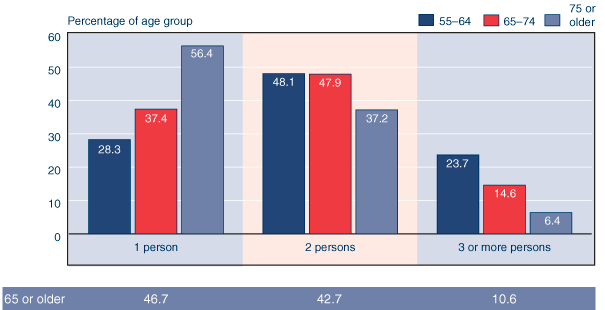 Show as table
Show as tableTable equivalent for chart. Percentage of CUs, by size and age Size of consumer unit 55–64 65–74 75 or older 65 or older 1 person 28.3 37.4 56.4 46.7 2 persons 48.1 47.9 37.2 42.7 3 or more persons 23.7 14.6 6.4 10.6 NOTE: Percentages may not add to 100 because of rounding.
Expenditures and income
- Total expenditures
- The sum of all expenditures made in 2002.
- Per capita expenditures
- Expenditures of consumer units divided by the size of the consumer unit.
- Total income
- The sum of all income sources before taxes in 2002, including the value of food stamps.
- Earned income
- Income from wages and salaries or self-employment in 2002, including businesses and farms.
Components of expenditures
- Housing
- The sum of all housing expenditures made in 2002, including the expenses associated with renting or owning a home such as rent, mortgage interest, property taxes, maintenance, utilities, furnishings, renters' or homeowners' insurance, home appliances, cleaning supplies, textiles, and luggage. It does not include payments toward mortgage principal.
- Housing tenure
- The family's principal place of residence during the survey. "Owner" includes families living in their own homes, cooperatives or condominium apartments, or townhouses. "Renter" includes families paying rent or living rent-free in lieu of wages.
- Food
- The sum of all food expenditures made in 2002, including expenditures made at grocery stores and restaurants.
- Health care
- The sum of all out-of-pocket health care expenditures made in 2002, including public and private health insurance, doctor visits, eye and dental care and aids, hospital services, lab tests, and prescription drugs.
- Transportation
- The sum of all transportation expenditures made in 2002, including the purchase of new and used cars and trucks; insurance; gas and motor oil; finance charges; maintenance and repairs; licenses; rentals; other charges; and fares for travel by airplane, bus, train, and taxi.
- Apparel
- The sum of all apparel expenditures made in 2002, including clothing, footwear, laundry, sewing, watches, jewelry, and storage.
- Entertainment
- The sum of all entertainment expenditures made in 2002, including club fees, sport fees, theater tickets, televisions, stereos, pet expenses, toys, hobbies, campers, boats, and sporting equipment.
- Other
- The sum of all other categories of expenditures made in 2002, including alcohol, personal care, reading, education, tobacco, miscellaneous items, cash contributions to persons or organizations outside the consumer unit, personal insurance, pension contributions, and Social Security payroll taxes.
- Travel
- Travel is a combination of the above categories presented as the sum of all expenditures made on out-of-town trips in 2002, including food; alcohol; lodging; gas; rental of autos, trucks, motorcycles, boats, campers, and other vehicles; parking; tolls; fares for travel by airplane, bus, train, and taxi; and recreation and entertainment.
Notes about the Data
- Data in this report represent expenditures made during calendar year 2002.
- Data are from the interview portion of the 2002 Consumer Expenditure Survey unless otherwise noted.
- Some charts contain data from an integration of the diary and the interview portions of the 2002 Consumer Expenditure Survey. In some cases, specific items such as mortgage interest are measured in either the interview survey or the diary survey. In other cases, specific items are measured in both the interview survey and the diary survey. In those cases, the source of data for the item is determined by which survey yields the smallest standard error for that item. These items are aggregated into summary categories, such as housing, which could include data from the interview and diary portions.
- Means, medians, and percentiles are shown. Because expenditure data tend to be highly skewed, means are influenced by high-spending outliers. In these cases, median and percentile figures provide a clearer picture of the distribution of expenditures. However, the interview and diary portions cannot be combined to calculate medians and percentiles because the two surveys have different questionnaires and samples. In order to use all of the data available, means, medians, and percentiles are shown.
- Expenditures are collected for consumer units (CUs).
- Estimates are based on weighted responses from a sample of the population, as follows:
Unweighted and weighted responses, by age Age group Unweighted Weighted
(millions)55–64 1,086 15.3 65–74 820 11.2 75 or older 791 10.8 65 or older 1,612 22.2 - The estimates in this chartbook, which are based on the 2002 Consumer Expenditure Survey Public-Use File, could vary from those published by the Bureau of Labor Statistics, because disclosure avoidance techniques may have been applied to the Public-Use File.
- Income figures refer to income before taxes. These figures include some noncash benefits such as the value of food stamps. Property taxes on owned dwellings and owned vacation homes and Social Security payroll taxes are included in expenditures.
- Income quartiles for consumer units aged 65 or older break CUs into four groups of roughly equal size according to their income level.
Income quartiles for consumer units Quartile Income Lowest $12,264 or less Low-middle More than $12,264 but less than or equal to $20,204 High-middle More than $20,204 but less than or equal to $34,976 Highest More than $34,976 - CUs that did not have complete income information were not included in this analysis. Consumer units that reported having no income across all income categories were excluded on charts that give data by income level or earned income. Approximately 17 percent of CUs aged 55 or older reported zero income across all income categories.
- Charts that show data by age group also show data for consumer units aged 65 or older in a shaded bar below or to the side of the chart.
- Data are sometimes represented using box plots. The upper and lower edges of the box plots denote the upper (75th) and lower (25th) percentiles. The middle 50 percent of the data is a measure of variability that is found between the upper and lower percentiles. An example of a box plot is found below.
Example box plot
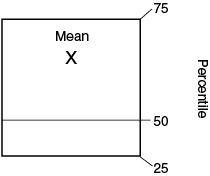
Expenditures of Consumer Units Aged 65 or older
Size of Expenditures
Consumer units aged 65 or older had a large range of total annual expenditures. In 2002, 16 percent spent less than $10,000, and 10 percent spent $50,000 or more. Median expenditures were $19,476. Mean expenditures, which were influenced by very high values, were $27,902.

| Total expenditures (dollars) | Percent |
|---|---|
| Less than 10,000 | 15.9 |
| 10,000–14,999 | 19.2 |
| 15,000–19,999 | 16.6 |
| 20,000–24,999 | 12.5 |
| 25,000–29,999 | 9.4 |
| 30,000–34,999 | 6.9 |
| 35,000–49,999 | 9.7 |
| 50,000 or more | 9.9 |
Per Capita Expenditures
Per capita expenditures account for differences in the number of persons in a consumer unit. 35 percent of CUs aged 65 or older had per capita expenditures of less than $10,000, and 26 percent had per capita expenditures of $10,000–$14,999. Median ($12,646) and mean ($17,596) per capita expenditures were about two-thirds of their total expenditures ($19,476 and $27,902, respectively).
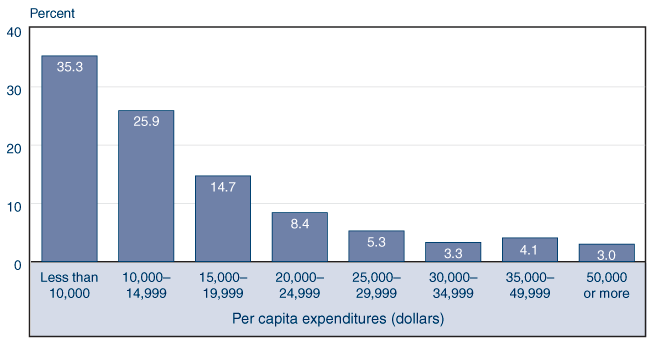
| Per capita expenditures (dollars) | Percent |
|---|---|
| Less than 10,000 | 35.3 |
| 10,000–14,999 | 25.9 |
| 15,000–19,999 | 14.7 |
| 20,000–24,999 | 8.4 |
| 25,000–29,999 | 5.3 |
| 30,000–34,999 | 3.3 |
| 35,000–49,999 | 4.1 |
| 50,000 or more | 3.0 |
Expenditures, by Income Quartile
Median expenditures were roughly three times greater for consumer units aged 65 or older in the highest income quartile ($34,216) than for those in the lowest income quartile ($10,996). The middle 50 percent of CUs with the lowest income spent between $7,752 and $16,452 (a difference of $8,700), and the middle 50 percent of CUs with the highest income spent between $25,058 and $51,211 (a difference of $26,153). This spending pattern indicates that CUs with the highest income had greater variability in their expenditures than did CUs with the lowest income.
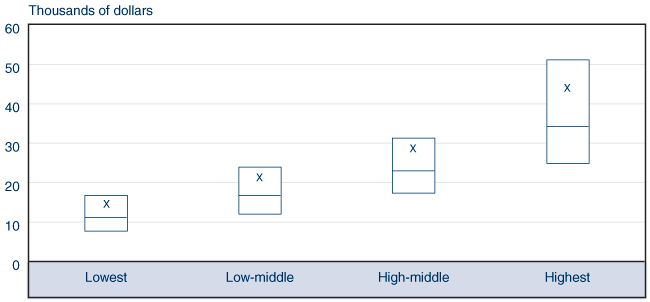
| Income quartile | 25th percentile | Median | 75th percentile | Mean |
|---|---|---|---|---|
| Lowest | 7,752 | 10,996 | 16,452 | 14,569 |
| Low-middle | 12,352 | 16,696 | 23,808 | 21,198 |
| High-middle | 17,368 | 22,924 | 31,268 | 28,571 |
| Highest | 25,058 | 34,216 | 51,211 | 44,097 |
| SOURCE: Income quartiles and expenditure percentiles are computed using the interview portion of the 2002 Consumer Expenditure Survey; means are computed using the interview and diary portions. | ||||
Per Capita Expenditures, by Income Quartile
Median per capita expenditures were 82 percent higher for consumer units in the highest income quartile ($17,376) than for those in the lowest income quartile ($9,550). The middle 50 percent of CUs aged 65 or older in the lowest income quartile had per capita expenditures between $6,740 and $13,896. Per capita expenditures were between $11,704 and $27,459 for the middle 50 percent of CUs in the highest income quartile.
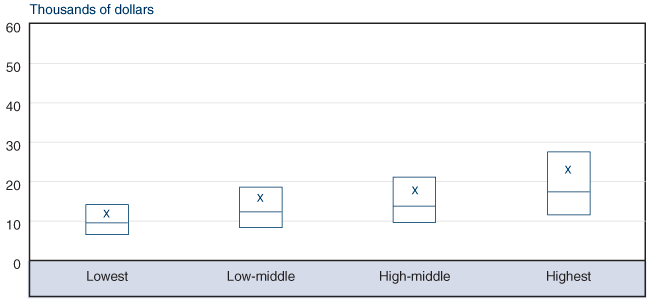
| Income quartile | 25th percentile | Median | 75th percentile | Mean |
|---|---|---|---|---|
| Lowest | 6,740 | 9,550 | 13,896 | 11,959 |
| Low-middle | 8,396 | 12,452 | 18,387 | 15,998 |
| High-middle | 9,655 | 13,777 | 20,981 | 17,744 |
| Highest | 11,704 | 17,376 | 27,459 | 22,947 |
| SOURCE: Income quartiles and expenditure percentiles are computed using the interview portion of the 2002 Consumer Expenditure Survey; means are computed using the interview and diary portions. | ||||
Expenditures, by Earned Income Status
Median expenditures for consumer units aged 65 or older with no earned income ($17,012) were 60 percent of median expenditures for those with earned income ($28,469). Almost three-quarters of CUs aged 65 or older had no earned income. About 60 percent of CUs with no earned income spent less than $20,000 annually compared with 27 percent of those with earned income. Conversely, 19 percent of CUs with earned income spent $50,000 or more compared with only 7 percent with no earned income. Per capita expenditures exhibited similar trends.
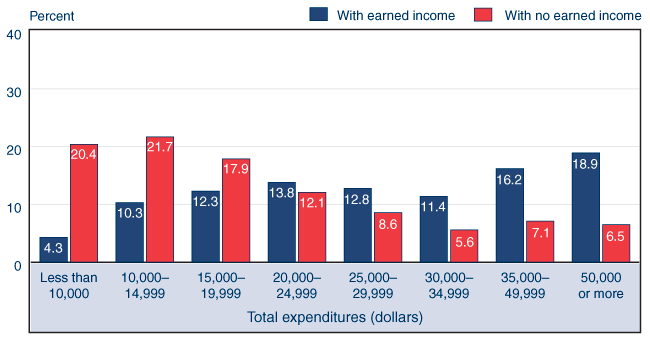
| Total expenditures (dollars) | With earned income |
With no earned income |
|---|---|---|
| Less than 10,000 | 4.3 | 20.4 |
| 10,000–14,999 | 10.3 | 21.7 |
| 15,000–19,999 | 12.3 | 17.9 |
| 20,000–24,999 | 13.8 | 12.1 |
| 25,000–29,999 | 12.8 | 8.6 |
| 30,000–34,999 | 11.4 | 5.6 |
| 35,000–49,999 | 16.2 | 7.1 |
| 50,000 or more | 18.9 | 6.5 |
Components of Expenditures
Housing was the largest component of expenditures (33 percent) for consumer units aged 65 or older. Other large components included transportation (16 percent), food (14 percent), and out-of-pocket health care (13 percent). Smaller components included entertainment (4 percent) and apparel (4 percent). Other items, including alcohol, personal care, reading, education, tobacco, miscellaneous items, cash contributions to persons or organizations outside the consumer unit, personal insurance, pension contributions, and Social Security payroll taxes, accounted for 17 percent. Social Security payroll taxes and pension contributions were small components of total expenditures (2 percent and 1 percent, respectively). Similar figures were found for components of per capita expenditures.
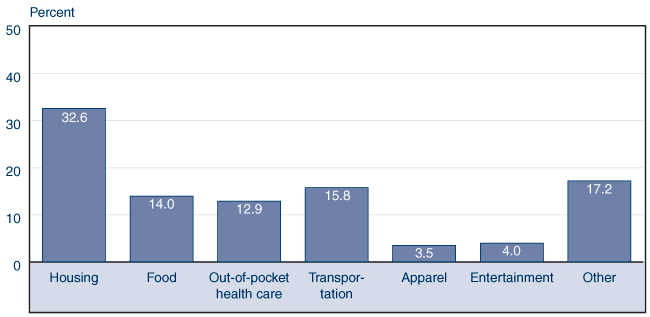
| Component | Mean percentage |
|---|---|
| Housing | 32.6 |
| Food | 14.0 |
| Out-of-pocket health care | 12.9 |
| Transportation | 15.8 |
| Apparel | 3.5 |
| Entertainment | 4.0 |
| Other | 17.2 |
Components of Expenditures, by Earned Income Status
Consumer units aged 65 or older spent similar shares of total expenditures on the various components regardless of whether or not they had earned income. Housing was the largest expenditure for both groups (29 percent for those with earned income and 34 percent for those with no earned income). Expenditures for out-of-pocket health care, food, and transportation ranged from 10 percent to 17 percent. Entertainment and apparel were smaller components, ranging from 3 percent to 5 percent. Other expenditures, including those for alcohol, personal care, reading, education, tobacco, miscellaneous items, cash contributions to persons or organizations outside the consumer unit, personal insurance, pension contributions, and Social Security payroll taxes, accounted for 22 percent of total expenditures for those with earned income (including 6 percent for Social Security payroll taxes and 2 percent for pension contributions) and 15 percent of total expenditures for those with no earned income (CUs with no earned income would not incur Social Security payroll taxes or pension contributions).
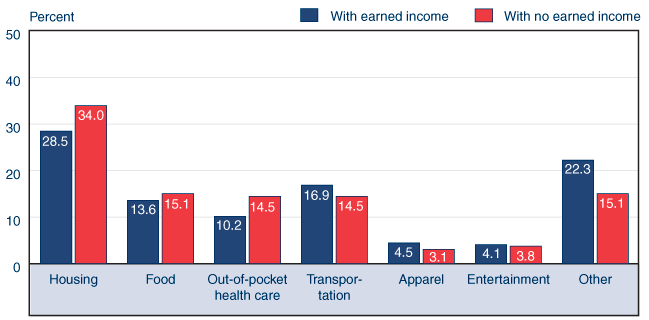
| Component | With earned income |
With no earned income |
|---|---|---|
| Housing | 28.5 | 34.0 |
| Food | 13.6 | 15.1 |
| Out-of-pocket health care | 10.2 | 14.5 |
| Transportation | 16.9 | 14.5 |
| Apparel | 4.5 | 3.1 |
| Entertainment | 4.1 | 3.8 |
| Other | 22.3 | 15.1 |
Components of Expenditures, by Income Quartile
The proportion of expenditures allocated for housing, food, and out-of-pocket health care were 32 percent higher for consumer units in the lowest income quartile than for those in the highest income quartile. CUs aged 65 or older in the lowest income quartile spent 38 percent of their total expenditures on housing compared with 28 percent for those in the highest income quartile. Food made up 17 percent of expenditures for CUs in the lowest income quartile and 13 percent for those in the highest income quartile. Both income groups allocated similar percentages to entertainment and apparel. CUs in the highest income quartile allocated nearly twice as much to other expenditures as did CUs in the lowest income quartile (23 percent compared with 12 percent).

| Component | With earned income |
With no earned income |
|---|---|---|
| Housing | 38.0 | 28.4 |
| Food | 16.9 | 13.2 |
| Out-of-pocket health care | 13.9 | 10.4 |
| Transportation | 13.4 | 17.4 |
| Apparel | 2.4 | 3.0 |
| Entertainment | 3.2 | 4.3 |
| Other | 12.1 | 23.3 |
Expenditures of Consumer Units, by Age
Size of Expenditures
Amounts of expenditures varied by age. Three age groups are shown in the remainder of this chartbook—those aged 55–64, 65–74, and 75 or older. Median expenditures were 80 percent higher for CUs aged 55–64 ($30,584) compared with CUs 75 or older ($16,878). The middle 50 percent of CUs aged 55–64 had expenditures between $18,881 and $50,005, and the middle 50 percent of CUs aged 75 or older had expenditures between $11,016 and $26,356. Per capita expenditures followed the same pattern.
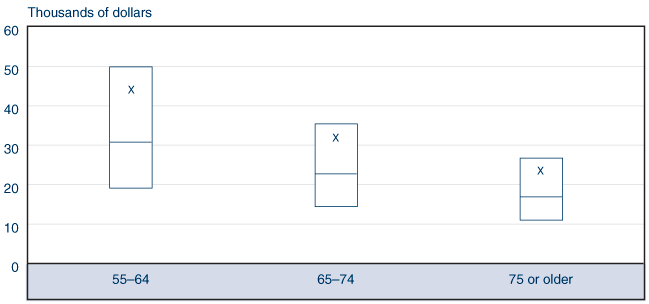
| Age group | 25th percentile | Median | 75th percentile | Mean |
|---|---|---|---|---|
| 55–64 | 18,881 | 30,584 | 50,005 | 44,037 |
| 65–74 | 14,358 | 22,636 | 35,324 | 32,003 |
| 75 or older | 11,016 | 16,878 | 26,356 | 23,597 |
| 65 or older | 12,516 | 19,476 | 30,916 | 27,902 |
| SOURCE: Expenditure percentiles are computed using the interview portion of the 2002 Consumer Expenditure Survey; means are computed using the interview and diary portions. | ||||
Components of Expenditures
The share of spending on different components of expenditures varied by age, with the largest share going to housing for all age groups. CUs aged 75 or older allocated 15 percent of expenditures to out-of-pocket health care compared with 7 percent for those aged 55–64. Compared with CUs aged 55–64, those aged 75 or older allocated 32 percent less of their expenditures to transportation (13 percent compared with 19 percent) and 24 percent less to other expenditures (16 percent compared with 21 percent). The share of expenditures allocated to food and housing were generally similar for all three age groups (13 percent to 14 percent and 31 percent to 35 percent, respectively), and only small proportions were allocated to entertainment and apparel (3 percent to 5 percent).
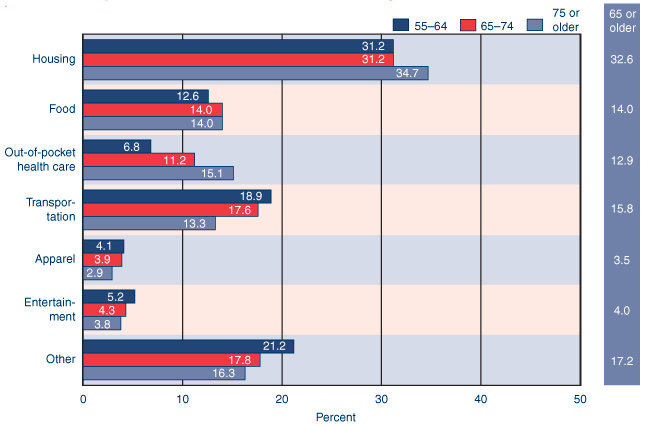
| Component | 55–64 | 65–74 | 75 or older | 65 or older |
|---|---|---|---|---|
| Housing | 31.2 | 31.2 | 34.7 | 32.6 |
| Food | 12.6 | 14.0 | 14.0 | 14.0 |
| Out-of-pocket health care | 6.8 | 11.2 | 15.1 | 12.9 |
| Transportation | 18.9 | 17.6 | 13.3 | 15.8 |
| Apparel | 4.1 | 3.9 | 2.9 | 3.5 |
| Entertainment | 5.2 | 4.3 | 3.8 | 4.0 |
| Other | 21.2 | 17.8 | 16.3 | 17.2 |
Housing Expenditures and Housing Tenure, by Age
Size of Housing Expenditures
Housing was the largest component of expenditures for all three age groups. Housing expenditures include rent, mortgage interest, property taxes, maintenance, utilities, furnishings, and other household supplies. The median percentage of expenditures for housing was about 33 percent for all three age groups. The median amount spent on housing decreased for each older age group, from $9,025 for CUs aged 55–64 to $6,736 for CUs aged 65–74 and $5,616 for CUs aged 75 or older. The middle 50 percent of CUs aged 55–64 had housing expenditures between $5,492 and $15,052, and the middle 50 percent of CUs aged 75 or older had expenditures between $3,568 and $8,892. On a per capita basis, median housing expenditures were between about $4,000 and $5,000.

| Age group | 25th percentile | Median | 75th percentile | Mean |
|---|---|---|---|---|
| 55–64 | 21.7 | 31.6 | 43.9 | 31.2 |
| 65–74 | 22.2 | 32.1 | 43.9 | 31.2 |
| 75 or older | 24.5 | 34.8 | 48.1 | 34.7 |
| 65 or older | 23.1 | 33.4 | 45.9 | 32.6 |
| SOURCE: Expenditure percentiles are computed using the interview portion of the 2002 Consumer Expenditure Survey; means are computed using the interview and diary portions. | ||||


| Age group | Housing expenditures | Per capita housing expenditures | ||||||
|---|---|---|---|---|---|---|---|---|
| 25th percentile | Median | 75th percentile | Mean | 25th percentile | Median | 75th percentile | Mean | |
| 55–64 | 5,492 | 9,025 | 15,052 | 13,731 | 2,817 | 4,796 | 8,121 | 7,310 |
| 65–74 | 4,296 | 6,736 | 11,132 | 9,972 | 2,452 | 4,064 | 6,830 | 6,053 |
| 75 or older | 3,568 | 5,616 | 8,892 | 8,185 | 2,399 | 3,978 | 6,632 | 5,984 |
| 65 or older | 3,882 | 6,136 | 10,081 | 9,099 | 2,423 | 4,023 | 6,716 | 6,020 |
| SOURCE: Expenditure percentiles are computed using the interview portion of the 2002 Consumer Expenditure Survey; means are computed using the interview and diary portions. | ||||||||
Housing Tenure
About 80 percent of consumer units in all three age groups owned a home, and most aged 65–74 and 75 or older owned a home without a mortgage. Homeowners aged 55–64 were about as likely to have a mortgage as to not have a mortgage (about 40 percent each). Homeowners aged 65–74 were twice as likely not to have a mortgage (58 percent compared with 26 percent), and homeowners aged 75 or older were approximately seven times more likely not to have a mortgage (67 percent compared with 9 percent). The mean percentage of total expenditures allocated to housing was lowest for homeowners without a mortgage (25 percent to 31 percent) and highest for CUs who rent (37 percent to 45 percent).
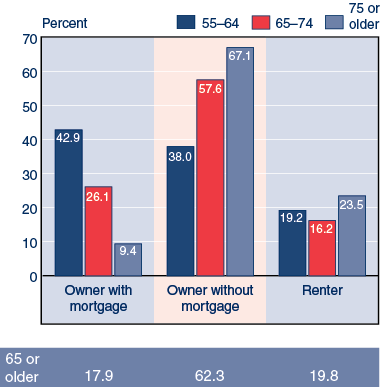
| Housing tenure | 55–64 | 65–74 | 75 or older | 65 or older |
|---|---|---|---|---|
| Owner with mortgage | 42.9 | 26.1 | 9.4 | 17.9 |
| Owner without mortgage | 38.0 | 57.6 | 67.1 | 62.3 |
| Renter | 19.2 | 16.2 | 23.5 | 19.8 |
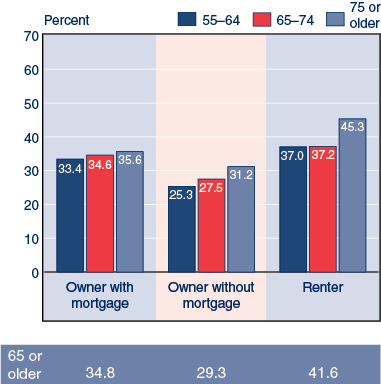
| Housing tenure | 55–64 | 65–74 | 75 or older | 65 or older |
|---|---|---|---|---|
| Owner with mortgage | 33.4 | 34.6 | 35.6 | 34.8 |
| Owner without mortgage | 25.3 | 27.5 | 31.2 | 29.3 |
| Renter | 37.0 | 37.2 | 45.3 | 41.6 |
Food Expenditures, by Age
Size of Food Expenditures
The median percentage of total expenditures spent on food was about 16 percent for all three age groups. The middle 50 percent of the distribution ranged from 10 percent to 24 percent. The median amount spent on food was about two-thirds higher for CUs aged 55–64 ($4,500) than for CUs aged 75 or older ($2,720). Median per capita food expenditures were about one-fifth higher for CUs aged 55–64 ($2,355) than for CUs aged 75 or older ($1,930).
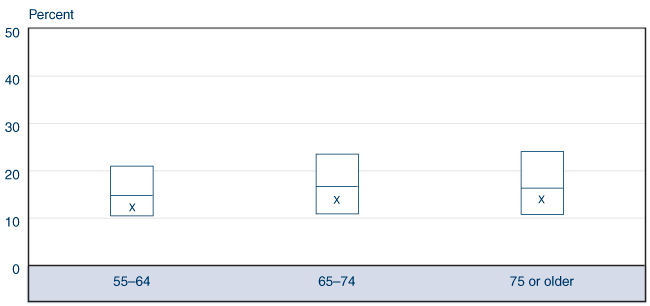
| Age group | 25th percentile | Median | 75th percentile | Mean |
|---|---|---|---|---|
| 55–64 | 10.1 | 14.8 | 21.0 | 12.6 |
| 65–74 | 11.2 | 16.7 | 23.4 | 14.0 |
| 75 or older | 11.0 | 16.4 | 23.9 | 14.0 |
| 65 or older | 11.1 | 16.5 | 23.6 | 14.0 |
| SOURCE: Expenditure percentiles are computed using the interview portion of the 2002 Consumer Expenditure Survey; means are computed using the interview and diary portions. | ||||


| Age group | Food expenditures | Per capita food expenditures | ||||||
|---|---|---|---|---|---|---|---|---|
| 25th percentile | Median | 75th percentile | Mean | 25th percentile | Median | 75th percentile | Mean | |
| 55–64 | 2,860 | 4,500 | 6,560 | 5,559 | 1,560 | 2,355 | 3,320 | 2,866 |
| 65–74 | 2,340 | 3,620 | 5,552 | 4,478 | 1,519 | 2,140 | 3,120 | 2,586 |
| 75 or older | 1,780 | 2,720 | 4,192 | 3,304 | 1,300 | 1,930 | 2,780 | 2,230 |
| 65 or older | 2,080 | 3,156 | 4,940 | 3,910 | 1,420 | 2,060 | 2,940 | 2,414 |
| SOURCE: Expenditure percentiles are computed using the interview portion of the 2002 Consumer Expenditure Survey; means are computed using the interview and diary portions. | ||||||||
Food Prepared and Eaten at Home
Older age groups allocated a larger share of food expenditures to food prepared and eaten at home than did younger age groups. CUs aged 75 or older were about twice as likely to allocate 95 percent or more of their food expenditures to food prepared and eaten at home than were CUs aged 55–64 (40 percent compared with 22 percent). The average percentage of food expenditures allocated to food prepared and eaten at home was 56 percent for CUs aged 55–64, 64 percent for CUs aged 65–74, and 67 percent for CUs aged 75 or older.
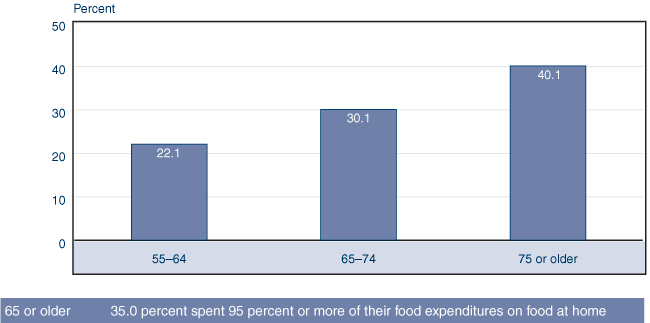
| Age group | Percent |
|---|---|
| 55–64 | 22.1 |
| 65–74 | 30.1 |
| 75 or older | 40.1 |
| 65 or older | 35.0 |
Out-of-Pocket Health Care Expenditures, by Age
Size of Out-of-Pocket Health Care Expenditures
Median out-of-pocket health care expenditures ranged from 5 percent of total expenditures for consumer units aged 55–64 to 14 percent for those aged 75 or older. The middle 50 percent of CUs aged 55–64 spent between 2 percent and 11 percent of total expenditures on health care, and the middle 50 percent of CUs aged 75 or older spent between 8 percent and 24 percent. Median out-of-pocket health care expenditures were more than 50 percent higher for CUs aged 75 or older compared with CUs aged 55–64 ($2,448 compared with $1,560) but were more than double on a per capita basis ($1,792 compared with $843). The Consumer Expenditure Survey is a survey of the noninstitutionalized population and therefore does not include nursing home residents and their expenditures.
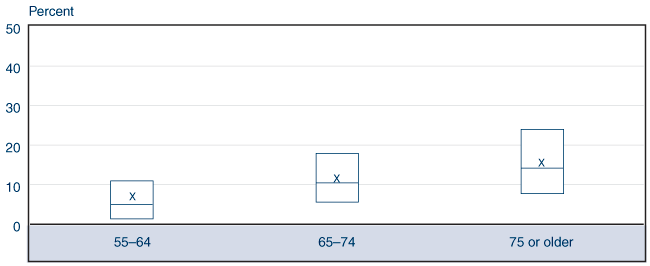
| Age group | 25th percentile | Median | 75th percentile | Mean |
|---|---|---|---|---|
| 55–64 | 1.5 | 5.0 | 10.9 | 6.8 |
| 65–74 | 5.6 | 10.6 | 18.0 | 11.2 |
| 75 or older | 7.8 | 14.4 | 23.9 | 15.1 |
| 65 or older | 6.6 | 12.3 | 21.0 | 12.9 |
| SOURCE: Expenditure percentiles are computed using the interview portion of the 2002 Consumer Expenditure Survey; means are computed using the interview and diary portions. | ||||


| Age group | Out-of-pocket health care expenditures | Per capita out-of-pocket health care expenditures | ||||||
|---|---|---|---|---|---|---|---|---|
| 25th percentile | Median | 75th percentile | Mean | 25th percentile | Median | 75th percentile | Mean | |
| 55–64 | 540 | 1,560 | 3,792 | 3,009 | 246 | 843 | 1,958 | 1,571 |
| 65–74 | 1,128 | 2,356 | 4,588 | 3,599 | 648 | 1,456 | 2,682 | 2,112 |
| 75 or older | 1,176 | 2,448 | 4,424 | 3,572 | 788 | 1,792 | 3,104 | 2,509 |
| 65 or older | 1,152 | 2,400 | 4,488 | 3,586 | 708 | 1,616 | 2,872 | 2,306 |
| SOURCE: Expenditure percentiles are computed using the interview portion of the 2002 Consumer Expenditure Survey; means are computed using the interview and diary portions. | ||||||||
Components of Out-of-Pocket Health Care Expenditures
Health insurance premiums accounted for the largest share of out-of-pocket health care spending for all age groups (45 percent to 53 percent). The portion of health care expenditures for medical services and drugs differed by age group. Medical services were the second largest component for CUs aged 55–64, and drugs were the second largest component for CUs aged 75 or older. Medical supplies accounted for only about 4 percent to 5 percent of health care expenditures for all age groups.
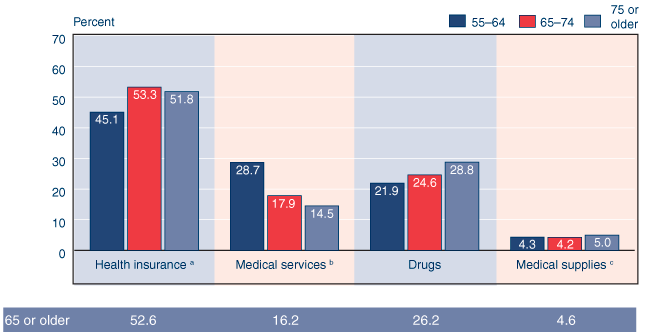
| Component | 55–64 | 65–74 | 75 or older | 65 or older |
|---|---|---|---|---|
| Health insurance a | 45.1 | 53.3 | 51.8 | 52.6 |
| Medical services b | 28.7 | 17.9 | 14.5 | 16.2 |
| Drugs | 21.9 | 24.6 | 28.8 | 26.2 |
| Medical supplies c | 4.3 | 4.2 | 5.0 | 4.6 |
Transportation Expenditures, by Age
Size of Transportation Expenditures
Transportation expenditures were lower for consumer units aged 75 or older than for those aged 55–64. This was true for the median percentage of total expenditures allocated to transportation (6 percent compared with 11 percent), median transportation expenditures ($1,024 compared with $3,262), and median per capita transportation expenditures ($720 compared with $1,696). Mean transportation expenditures are above the 75th percentile because of large expenditures by CUs who purchased cars or trucks during the survey period.
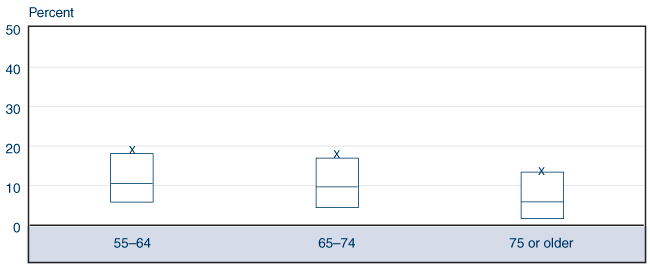
| Age group | 25th percentile | Median | 75th percentile | Mean |
|---|---|---|---|---|
| 55–64 | 5.9 | 10.8 | 18.0 | 18.9 |
| 65–74 | 4.6 | 9.7 | 16.9 | 17.6 |
| 75 or older | 1.6 | 5.9 | 13.1 | 13.3 |
| 65 or older | 3.0 | 8.0 | 15.1 | 15.8 |
| SOURCE: Expenditure percentiles are computed using the interview portion of the 2002 Consumer Expenditure Survey; means are computed using the interview and diary portions. | ||||


| Age group | Transportation expenditures | Per capita transportation expenditures | ||||||
|---|---|---|---|---|---|---|---|---|
| 25th percentile | Median | 75th percentile | Mean | 25th percentile | Median | 75th percentile | Mean | |
| 55–64 | 1,528 | 3,262 | 6,604 | 8,324 | 805 | 1,696 | 3,240 | 4,176 |
| 65–74 | 912 | 2,220 | 4,628 | 5,629 | 557 | 1,280 | 2,670 | 3,088 |
| 75 or older | 240 | 1,024 | 2,640 | 3,128 | 180 | 720 | 1,732 | 1,984 |
| 65 or older | 480 | 1,564 | 3,700 | 4,404 | 330 | 994 | 2,208 | 2,547 |
| SOURCE: Expenditure percentiles are computed using the interview portion of the 2002 Consumer Expenditure Survey; means are computed using the interview and diary portions. | ||||||||
Components of Transportation Expenditures
Almost all transportation expenditures were for the purchase and maintenance of vehicles. The purchase of new and used cars and trucks accounted for 46 percent of transportation expenditures for CUs aged 55–64 and 38 percent for CUs aged 75 or older. Costs for other vehicle expenditures made up 48 percent of transportation expenditures for CUs aged 55–64 and 56 percent for CUs aged 75 or older. For all age groups shown, only 6 percent to 7 percent of transportation expenditures went to public transportation.
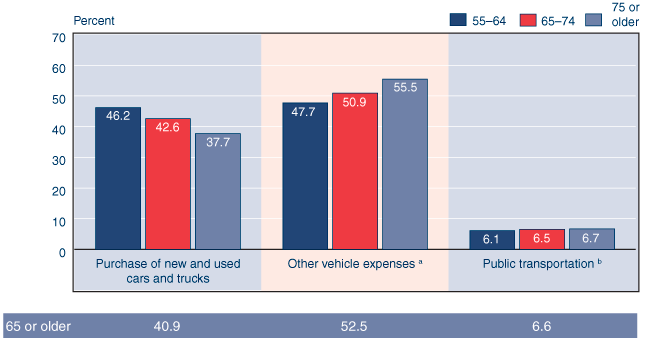
| Component | 55–64 | 65–74 | 75 or older | 65 or older |
|---|---|---|---|---|
| Purchase of new and used cars and trucks | 46.2 | 42.6 | 37.7 | 40.9 |
| Other vehicle expenses a | 47.7 | 50.9 | 55.5 | 52.5 |
| Public transportation b | 6.1 | 6.5 | 6.7 | 6.6 |
Other Expenditures, by Age
Size of Other Expenditures
Other expenditures include such items as alcohol, personal care, reading, education, tobacco, miscellaneous items, cash contributions to persons or organizations outside the consumer unit, personal insurance, pension contributions, and Social Security payroll taxes. Median other expenditures as a percentage of total expenditures ranged from 17 percent among CUs aged 55–64 to 8 percent among CUs aged 75.
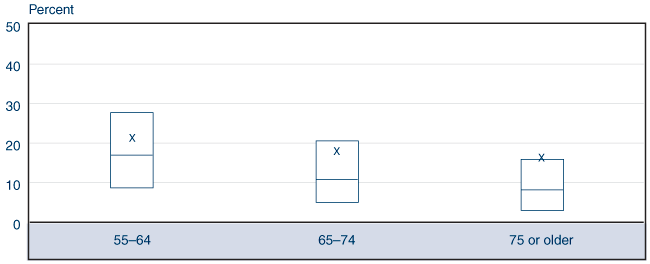
| Age group | 25th percentile | Median | 75th percentile | Mean |
|---|---|---|---|---|
| 55–64 | 8.6 | 17.0 | 27.7 | 21.2 |
| 65–74 | 5.1 | 10.9 | 20.3 | 17.8 |
| 75 or older | 2.9 | 8.2 | 15.9 | 16.3 |
| 65 or older | 3.9 | 9.6 | 18.2 | 17.2 |
| SOURCE: Expenditure percentiles are computed using the interview portion of the 2002 Consumer Expenditure Survey; means are computed using the interview and diary portions. | ||||


| Age group | Other expenditures | Per capita other expenditures | ||||||
|---|---|---|---|---|---|---|---|---|
| 25th percentile | Median | 75th percentile | Mean | 25th percentile | Median | 75th percentile | Mean | |
| 55–64 | 2,104 | 5,129 | 11,055 | 9,331 | 1,068 | 2,682 | 5,685 | 4,873 |
| 65–74 | 910 | 2,524 | 5,529 | 5,711 | 568 | 1,452 | 3,105 | 3,325 |
| 75 or older | 420 | 1,344 | 3,264 | 3,849 | 320 | 908 | 2,268 | 2,664 |
| 65 or older | 608 | 1,900 | 4,458 | 4,802 | 420 | 1,174 | 2,662 | 3,002 |
| SOURCE: Expenditure percentiles are computed using the interview portion of the 2002 Consumer Expenditure Survey; means are computed using the interview and diary portions. | ||||||||
Components of Other Expenditures
The allocation of other expenditures differs among age groups. Cash contributions were the largest component of other expenditures for CUs aged 65–74 and 75 or older (28 percent and 45 percent). Social Security payroll taxes were the largest component of other expenditures for CUs aged 55–64 (29 percent).
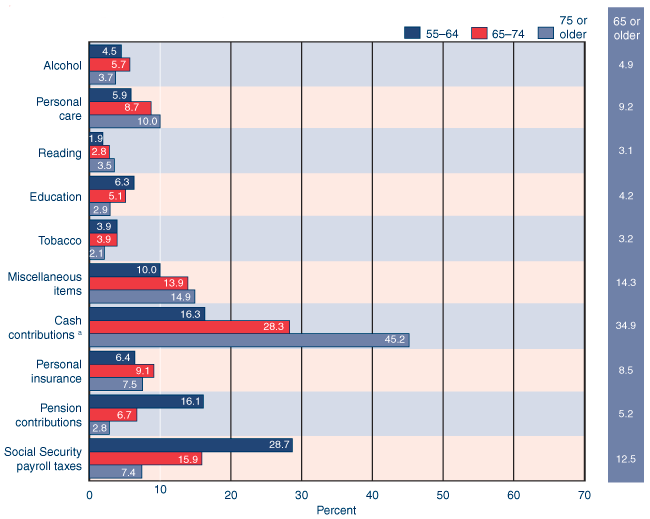
| Component | 55–64 | 65–74 | 75 or older | 65 or older |
|---|---|---|---|---|
| Alcohol | 4.5 | 5.7 | 3.7 | 4.9 |
| Personal care | 5.9 | 8.7 | 10.0 | 9.2 |
| Reading | 1.9 | 2.8 | 3.5 | 3.1 |
| Education | 6.3 | 5.1 | 2.9 | 4.2 |
| Tobacco | 3.9 | 3.9 | 2.1 | 3.2 |
| Miscellaneous items | 10.0 | 13.9 | 14.9 | 14.3 |
| Cash contributions a | 16.3 | 28.3 | 45.2 | 34.9 |
| Personal insurance | 6.4 | 9.1 | 7.5 | 8.5 |
| Pension contributions | 16.1 | 6.7 | 2.8 | 5.2 |
| Social Security payroll taxes | 28.7 | 15.9 | 7.4 | 12.5 |
Travel Expenditures, by Age
Size of Travel Expenditures
No more than 37 percent of consumer units in the three age groups shown had travel-related expenditures, and the percentage who had such expenditures decreased with age. Travel comprises elements from the housing, food, transportation, and entertainment expenditure categories that are spent on out-of-town trips. This category includes food; alcohol; lodging; gas; rental of autos, trucks, motorcycles, boats, campers, and other vehicles; parking; tolls; fares for travel by airplane, bus, train, and taxi; and recreation and entertainment expenses on out-of-town trips. About 37 percent of CUs aged 55–64, 31 percent of CUs aged 65–74, and 18 percent of CUs aged 75 or older had some expenditures for travel. Among CUs with travel expenditures, median expenditures for travel were about 5 percent of total expenditures across all age groups.
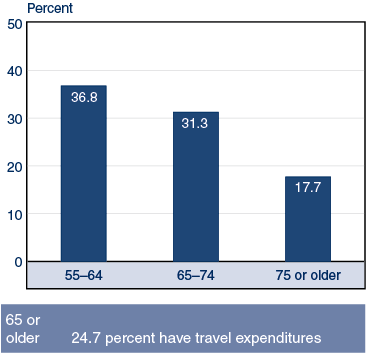
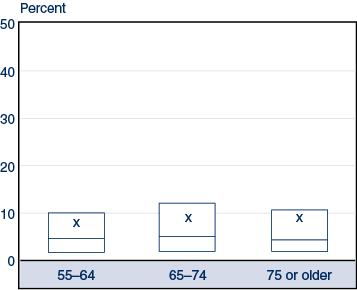
| Age group | 25th percentile | Median | 75th percentile | Mean |
|---|---|---|---|---|
| 55–64 | 1.7 | 4.6 | 10.0 | 7.7 |
| 65–74 | 1.8 | 5.1 | 12.1 | 9.1 |
| 75 or older | 1.8 | 4.3 | 10.5 | 8.9 |
| 65 or older | 1.8 | 4.5 | 11.5 | 9.0 |
| SOURCE: Interview portion of the 2002 Consumer Expenditure Survey. | ||||